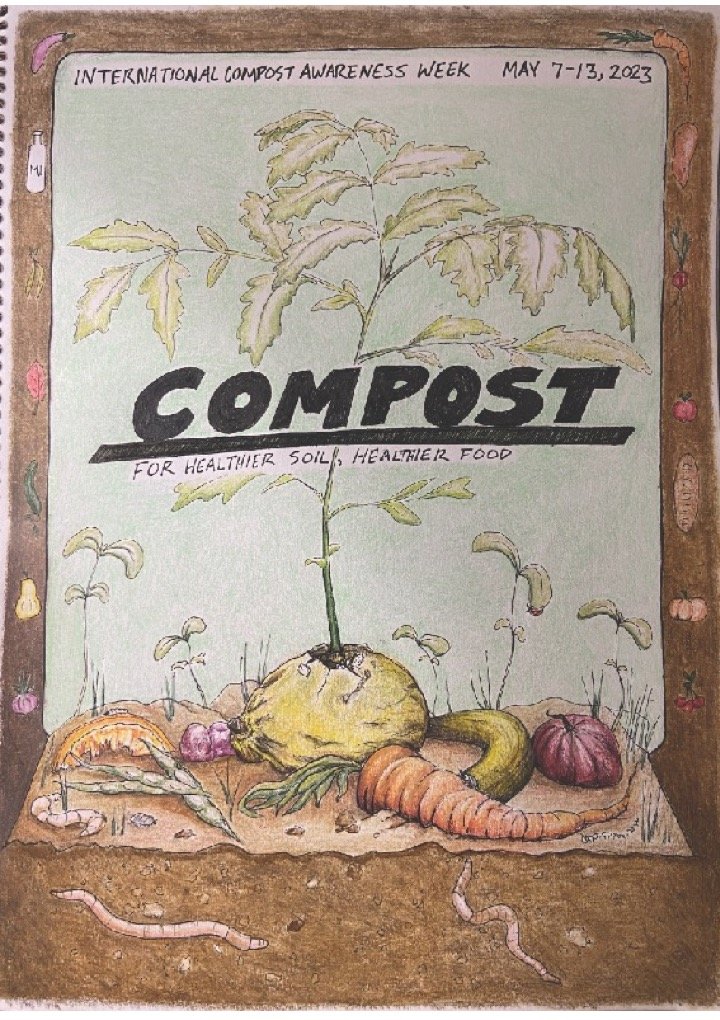
by Maddie Mezitt
Composting can be done by everybody, anwhere. The poster shows that enriching your soils, feeding your plants and increasing biodiversity can be as simple as tossing a rotting squash into your garden. Pillbugs, worms and centipedes are an indicator of nutrient rich soils. My earliest memory of composting is my dad tossing some rotted fruits and veggies into our garden. Over a few weeks, I would watch them rot, be eaten by bugs, and eventually, they would dissapear. A tomato plant is not necessarily going to grow out of a squash as in my poster. My hopes are to show the audience that your uneaten food waste can indirectly feed you. Your food waste can feed your soils, your plants, and eventually provide you with food again. It is a beautifully simple, environmentally friendly way to dispose of food scraps, feed your plants, and provide healthy food. Composting creates healthier soil and healthier foods.
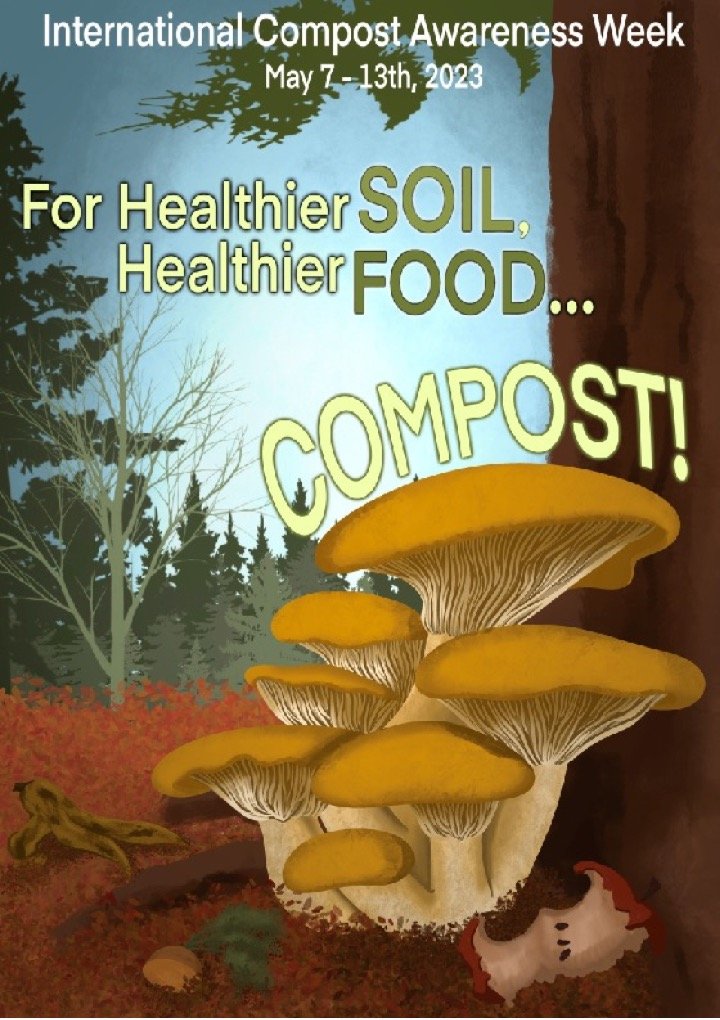
by Ethan Lareau
In the spirit of International Compost Awareness Week, I drew inspiration from my background in forest and natural resource management to create a poster that brings to light the importance of composting food scraps by imitating naturally-occurring biological decomposition processes that transpire daily in global forested ecosystems. As humans, we are interwoven into the ecological fabric of the celestial planet we call Earth. Given our species' spatial extent and reciprocal influence, we can support or degrade the environmental functions that allow us to survive and, in some cases, thrive. Much like the pictured fruiting body of fungal hyphae (mushrooms) that form mycorrhizal networks which enhance the decomposition and transfer of nutrients within a forest ecosystem, humans can accommodate the biological process that allow food scraps to become nutrient-rich, life-sustaining soil. Such soil can supplement the growth of future food production – increasing crop yields and limiting necessary resource inputs. By reducing our production of food scraps and ensuring that unavoidable food waste is composted in an appropriate and sustainable manner, we, as humans, can promote the recycling of critical nutrients and ecological properties that will allow not only us but the environments around us to survive and even flourish. So, the next time you are about to discard food scraps into the trash, consider how you can better emulate the biological functions of fungal networks and their role in sustaining our fragile planet.
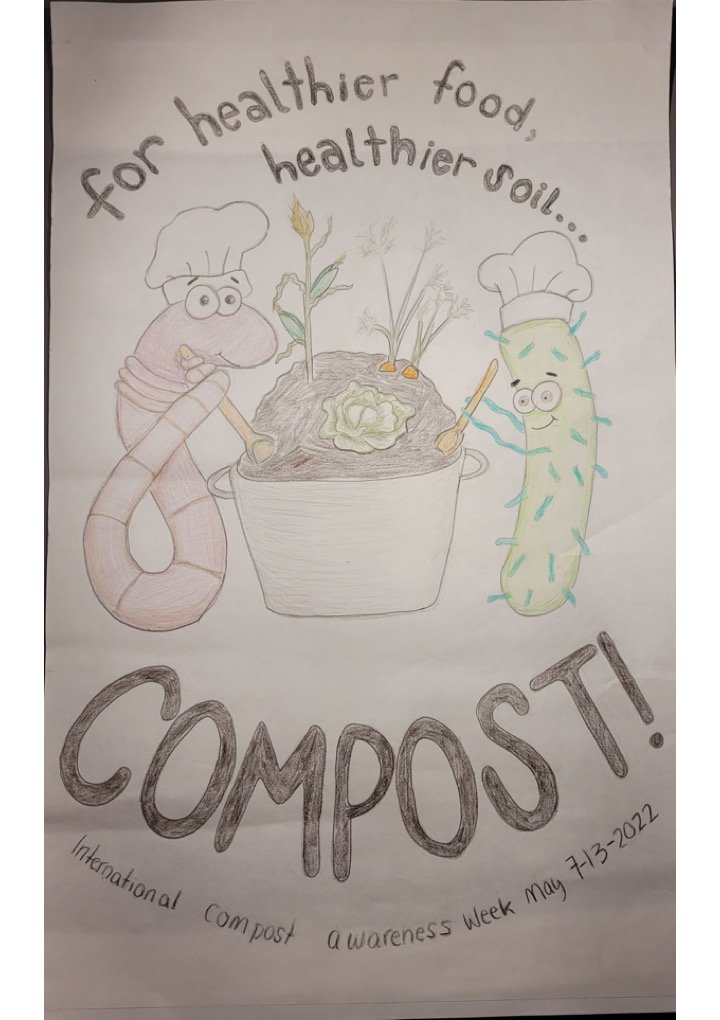
by Ellie Churchill
This poster draws its inspiration from the work the soil ecosystem does to recycle food waste back into delicious, nutritious food. It features an earthworm, because they are widely associated with healthy soil and easily recognized, as well as a bacterium to bring awareness to the hidden role of microbes in the nutrient cycling process. Because the theme includes both healthy soil and healthy food, the worm and bacterium are imagined as chefs, using delicious compost ingredients to cook up some healthy, yummy vegetables. I thought this cooking metaphor was apt for compost, as both making a meal and making compost is considered to be both art and science, and includes careful and inspired combination of various ingredients to create a whole that is better than the sum of its parts.
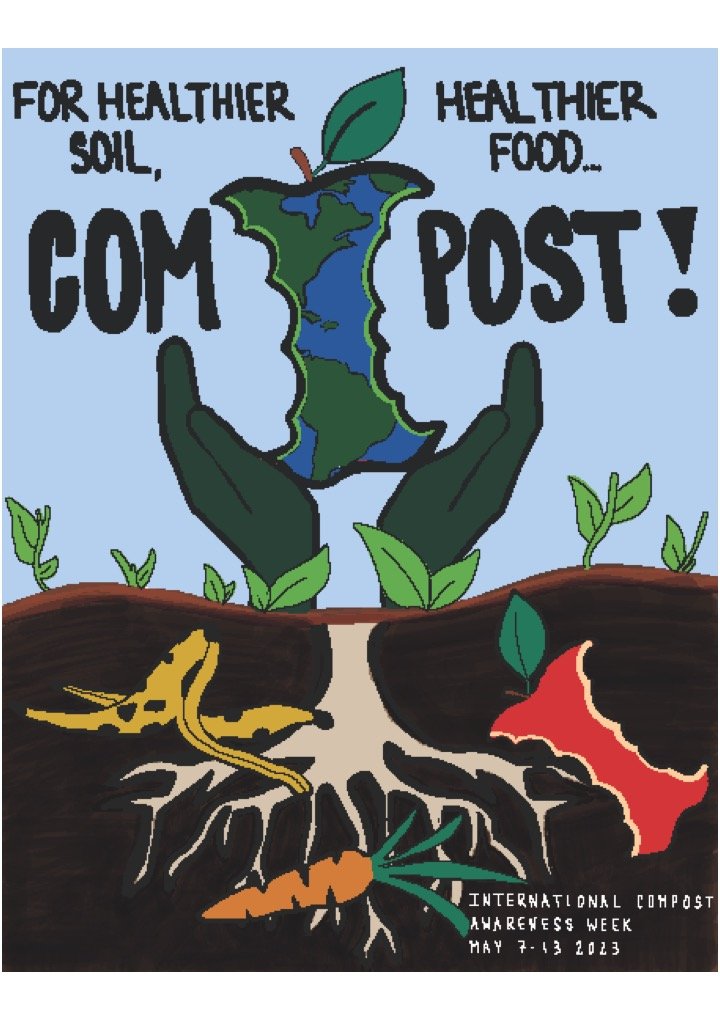
by Andie Cornish
The design route I chose to go was encompassing the idea that as humans we hold the future of our earth in our hands, and by placing compost in that future we can help ensure sustainable growth and living. The eaten and decomposing fruit in the dirt represents the importance of composting scraps to create healthy soil and in turn growth of plants and life. The hands are green to represent a plant itself growing from the soil to display the cyclical nature of compost as well as humans and nature being one.
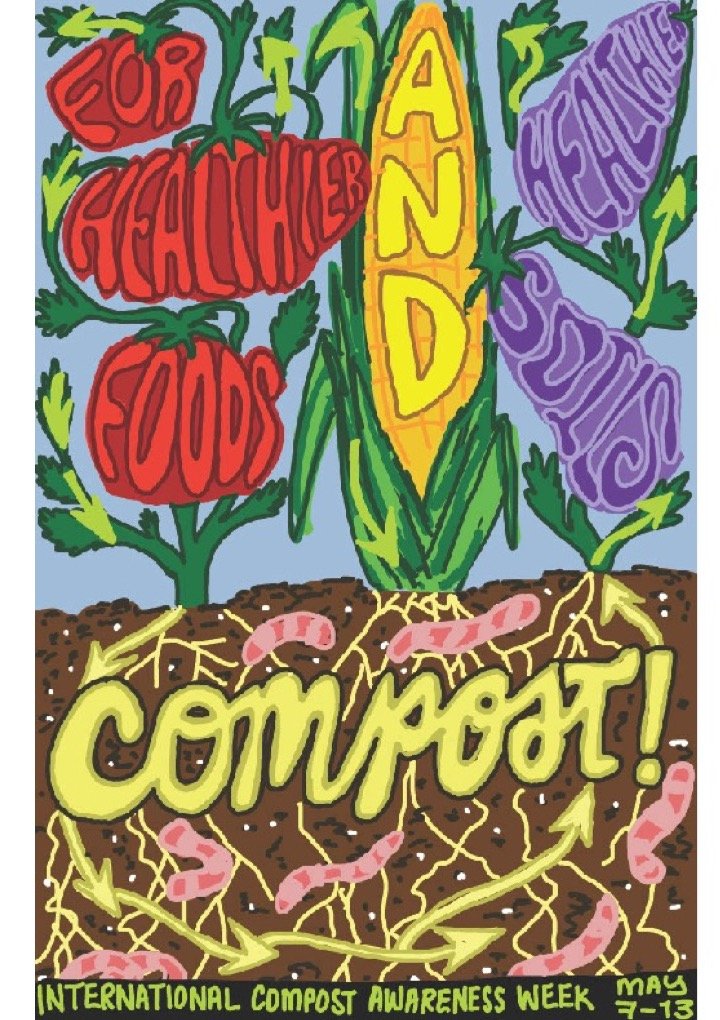
by Grace Weckesser
The poster that I created for ICAW highlights the recycling aspect of composting that makes it the sustainable practice that it is. Our food, when the discards after we eat or use it remain, can be recycled back into the Earth as compost, to build and amend soil, and therefore grow more food. The arrows that cycle from the veggies to the soil and back out again convey the circularity involved in composting and crop production. I also included worms as a nod to vermicomposting! I am proud of my poster and I think its attractiveness along with its message would be effective in honoring the International Compost Awareness Week.
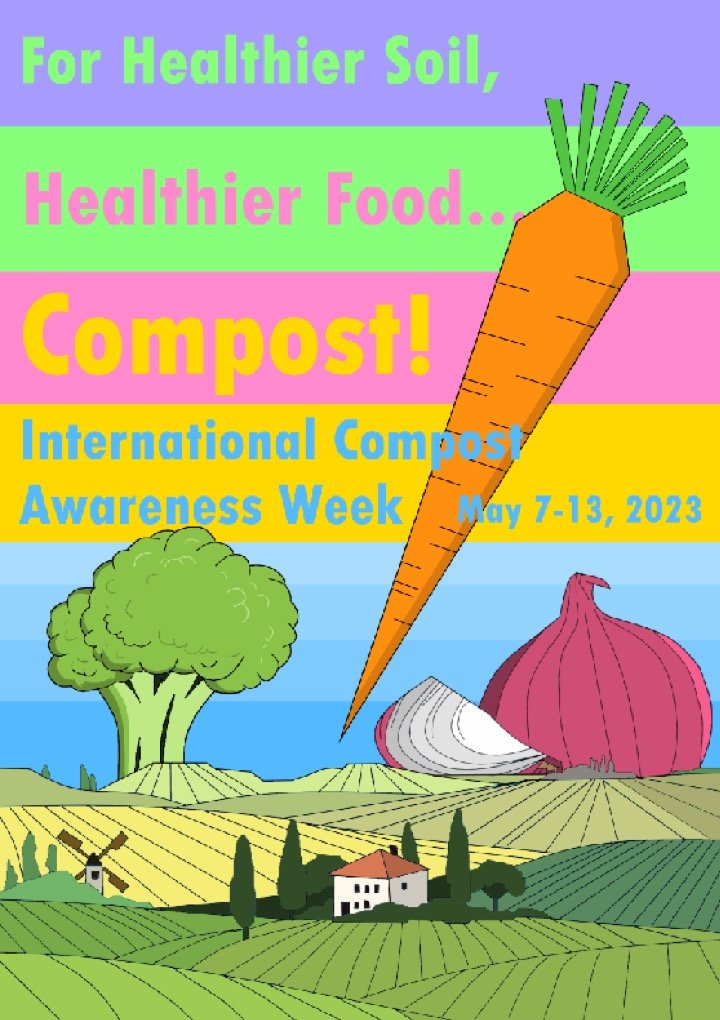
by Milo Brown
For this project I knew I was not a skilled physical artist so I created something digital with my limited talents. I was inspired by one of the previous winners, who layed out their poster with different color blocks, each block containing a part of the theme message. The rest of the poster, though, is totally my own. I chose a brighter color scheme because the theme is healthy food and healthy soils. I decided I'd create a farm landscape with really big vegetables (presumably the result of healthier soil) towering over it triumphantly. For the vegetables I knew they had to be colorful so I chose a carrot, a red onion, and for some classic green I added a broccoli. I feel really good about what I created even though I'm not a talented artist and I think my poster is a lighthearted and fun way to celebrate compost awareness week. :)
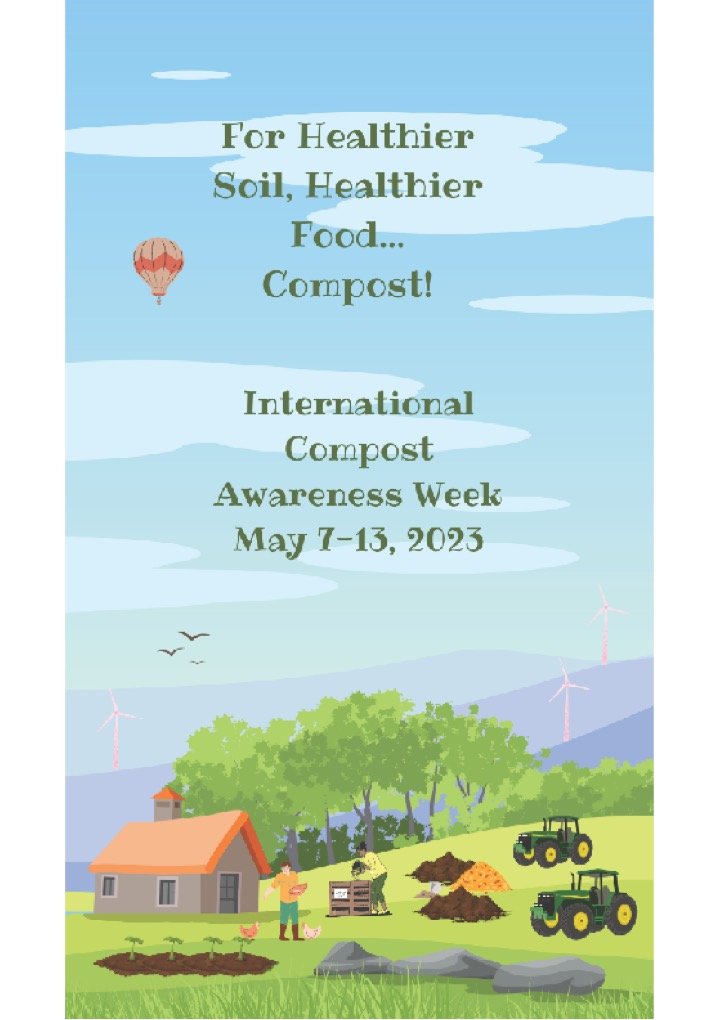
by Thomas Collins
For my poster, the design reflects a picturesque view of Vermont, and it includes a farm with composting in process. For my poster the inspiration behind the design was our field trip to the Green Mountain Compost center. In my poster, there is a farmer feeding chickens, followed by a compost manager who is churning the pile. The tractors are included in the poster because they are used for enhanced farming, and I think that they represent the agriculture industry here in Vermont. My goal of the poster was to represent an ideal scene in Vermont, and to represent the importance of the agriculture industry and it's importance to composting. While composting and agriculture go hand in hand, I believe that both have an important relationship which affects the quality of food.

by Frieda Kahan
My poster for the compost awareness week 2023 is a multimedia collage. I utilized several materials such as, but not limited to, paper, magazine clippings, pipe cleaners, stickers, stamps, paint pens, corks, googly eyes, and more! The general poster is meant to show the effectiveness of composting as well as just how it works. At the bottom, one can see a large amount of food piled on top of each other, meant to represent food scraps from one’s kitchen. Additionally there are cork halves in the pile to look like wood to represent the need for yard waste and carbon sources in compost piles. There are small worms made out of pipe cleaners with googly eyes for fun wriggling through the food and wood pile to show the essential biotic element of compost piles. Directly above this lovely compost pile is a healthy looking orange orchard and strawberry field with a singular cow. These are made with stickers, fake flowers, and stamps and the aim of their composition is to show how integral healthy soil is for all of our healthy food systems. Above that is a sky with clouds and the required words written in the sky and in the clouds.

by Erica Hoover
My poster features three successive piles of organic material on a gradient background. The backmost pile contains indiscernible contents, the middle pile contains food scraps, and the frontmost pile depicts healthy soil with vegetables and flowers growing in it, as well as a belowground view. In between these front two piles there is an open bin full of compost with a small plant growing out of it. I wanted to emphasize the "health" aspect of the poster theme, and so I originally designed this bin to look like a medicine/pill bottle, with a red cross to further get the point across. I was relating compost to a medicine that you can give to your soil to help supplement it, as it has a number of desirable affects on the soil - much like a bottle of DayQuil has a number of desirable affects on you when you're sick with a cold. I also added a little bandaid to the plant growing in the compost to add to the "healthy plants" idea, and I put worms below the ground in the soil since the presence of certain worms is commonly used as an indicator of soil health.
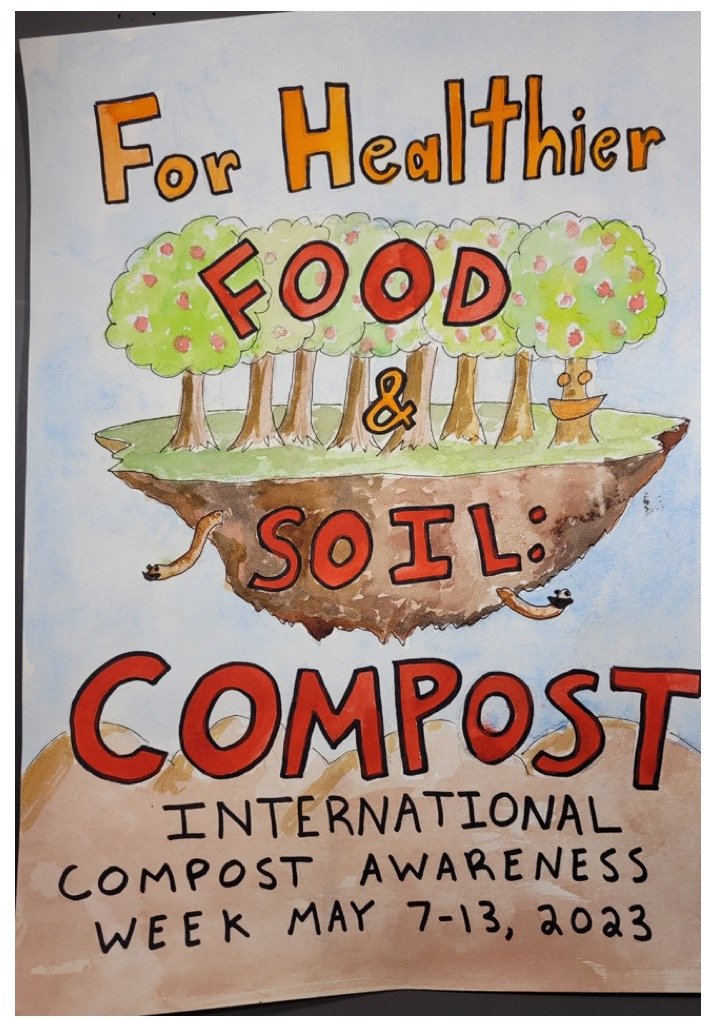
by Joey Looney
My poster concept was to display visually the quote “For Healthier Food & Soil: Compost.” I chose to display the word food over a row of apple trees. These trees look happy, vibrant, and healthy, full of a surplus of apples, the healthy food. Then to show the connection between soil and plants that is often overlooked by the public, I raised the row of trees up so the soil beneath them could be seen. The word soil overlays this, and “happy worms” can be seen poking out. Then I overlayed the final word in the quote, compost, over a row of compost piles. I used bright oranges and reds for the lettering to catch one’s eye from a distance and kept the visuals simple and light as to not distract while still being appealing.
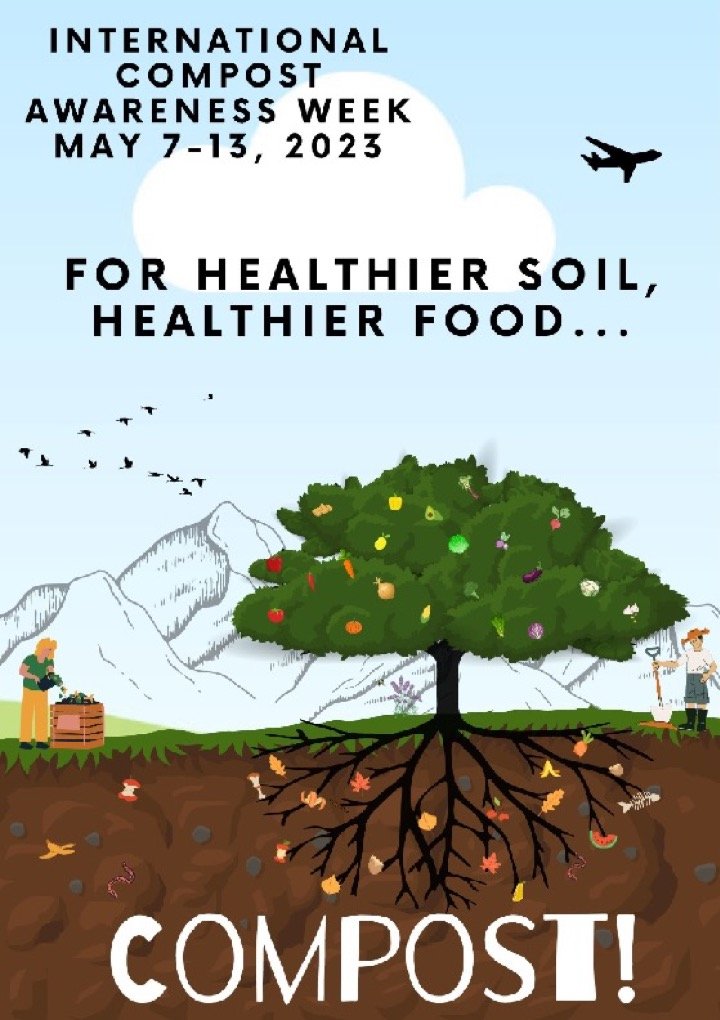
by Lillian Bartlett
This poster represents the components of compost feeding the roots of our food. On the left a woman is adding food scraps to her compost pile, showing the “healthier soil” portion of the theme. This compost is in the soil, visually represented with the various food scraps and leaves on the roots, providing much needed nutrients for the tree. These nutrients feed all of the crops we consume and the tree is covered in different vegetables showing the variety of food compost supports. This healthy soil is producing a high yield of bright, nutrient rich foods for human consumption.
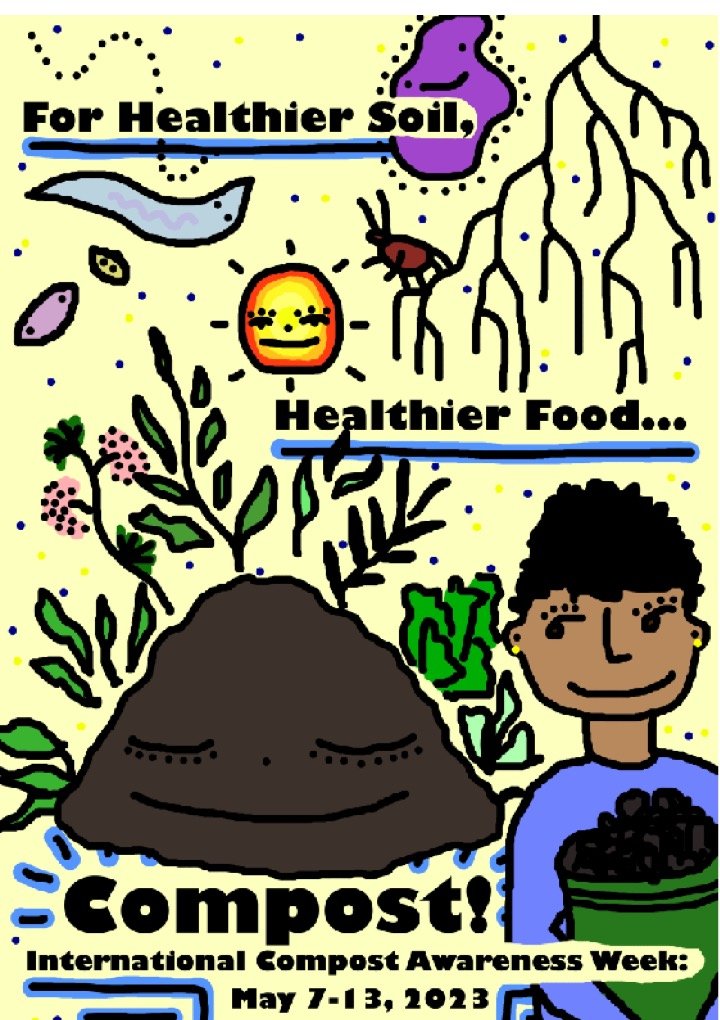
by Charlie Metcalfe
In this poster, I wanted to show the full cycle of the composting process, and all the actors involved. I’ve been experimenting with zine making and graphic novel-type illustration and wanted to bring in elements that would give the poster a hand-drawn and emotive graphic novel style. I was particularly inspired by the story collection The Most Costly Journey, where the simple drawing styles can add a great deal of impact and life to the stories of immigrant farmworkers, and by the illustrations on the pizza boxes at the flatbread company in Portland ME, ‘the five faces of hunger’, which always make me think of good food and intentional community. In this poster I try to convey the sense of compost-dwelling organisms, humans, plants, and abiotic factors like rain and sun all working together as a mutually beneficial community.

by Max Perrotto
My poster is supposed to show the theme of healthy food and soil through a heart-shaped root vegetable. There are several food scraps in the soil surrounding the plant which acts as a good visual cue for composting, the central theme at the bottom. The soil with compost in it is growing a large, heart-shaped vegetable, a big heart being a symbol of vigor and health. The design, I think, is simple but clearly shows the story to be told, that composting improves the health of nature and that which comes from it.
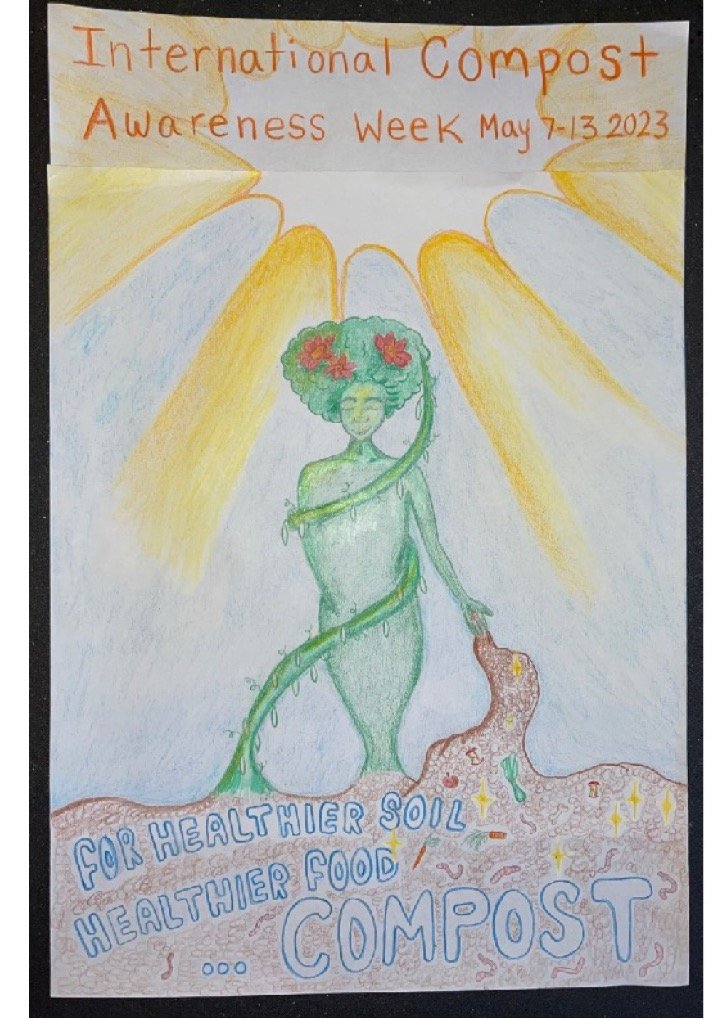
by Sarah Wright
In my concept for the poster I wanted to highlight the beauty of what can come from fertile soil, compost being a huge factor in creating such vivacious soil, I wanted it to stand out. I added sparkles coming out of the compost to entail the magical properties it possesses. I had the sun radiating on the large pea plant to highlight its life, and largeness. The pea plant is also a lady, who is using her left hand to pour compost into the ground at her feet. As this is an international awareness week, I wanted this pea lady person to embody everyone, that everyone can see themselves in her place, tending to the land and creating healthy soil and food from the compost that they are giving to the earth. I feel as if we should be taking care of this beautiful place that we live on, and I wanted to show that there is a way for us to give to the earth and it will give back to us. “For healthier soil, healthier food…COMPOST!”
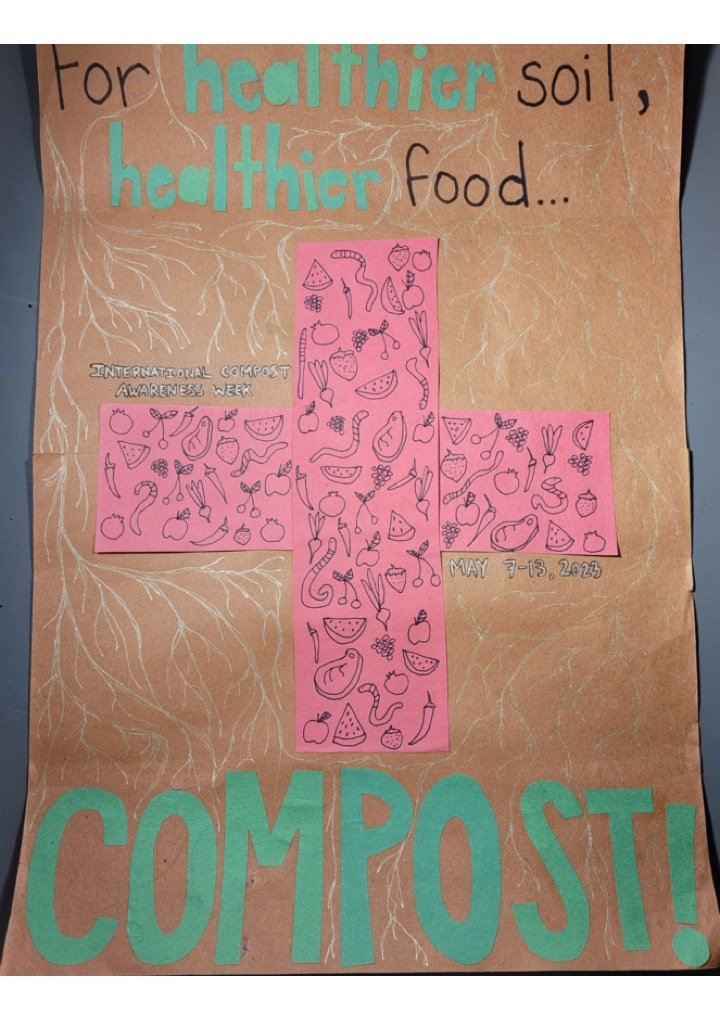
by Jade Galinski
For my poster, I wanted to focus on how compost improves soil health. The background is brown to represent soil and in the center is a red cross as a symbol of health. Inside the red cross I drew various red foods that can be composted as well as earthworms. The food drawings could be food that is being composted or food that is being grown from compost, and the worms are an indicator of soil health and also aid in the composting process. I chose to make the words “compost” and “healthier” green to add contrast and to represent how composting is good for the environment. In the background I also included gold roots to make the background more interesting and because roots are important for building healthy soils. I chose to do a collage because I’m not very good at Photoshop and I feel that soil, as well as compost, are also collages of all the separate parts that work together to make them up.
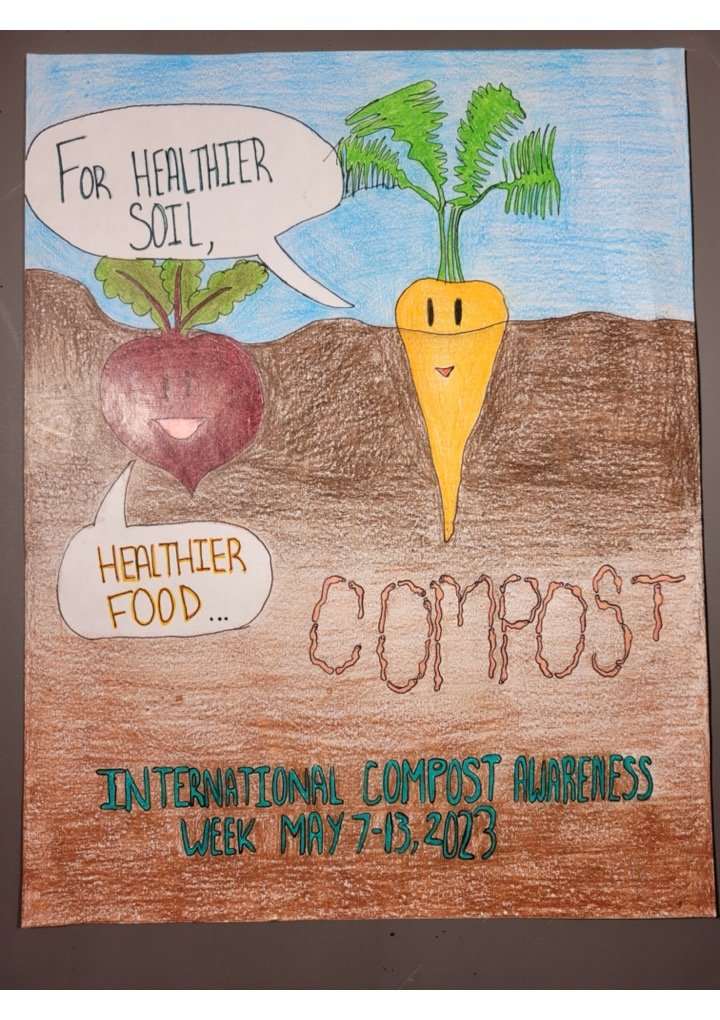
by Victoria Peguri
As soon as I heard about this project, I knew that I wanted to incorporate worms into it somehow, hence the lettering in compost. I also knew I wanted to emphasize the importance of compost in building a healthy soil, specifically in agricultural settings. I figured that including both the carrot and the beet would create a scene reminiscent of a home garden, making people more aware of composting on a more individual level. Ultimately, I wanted the poster to be fun and easy to read, and I thought talking veggies would be a great way to achieve that!
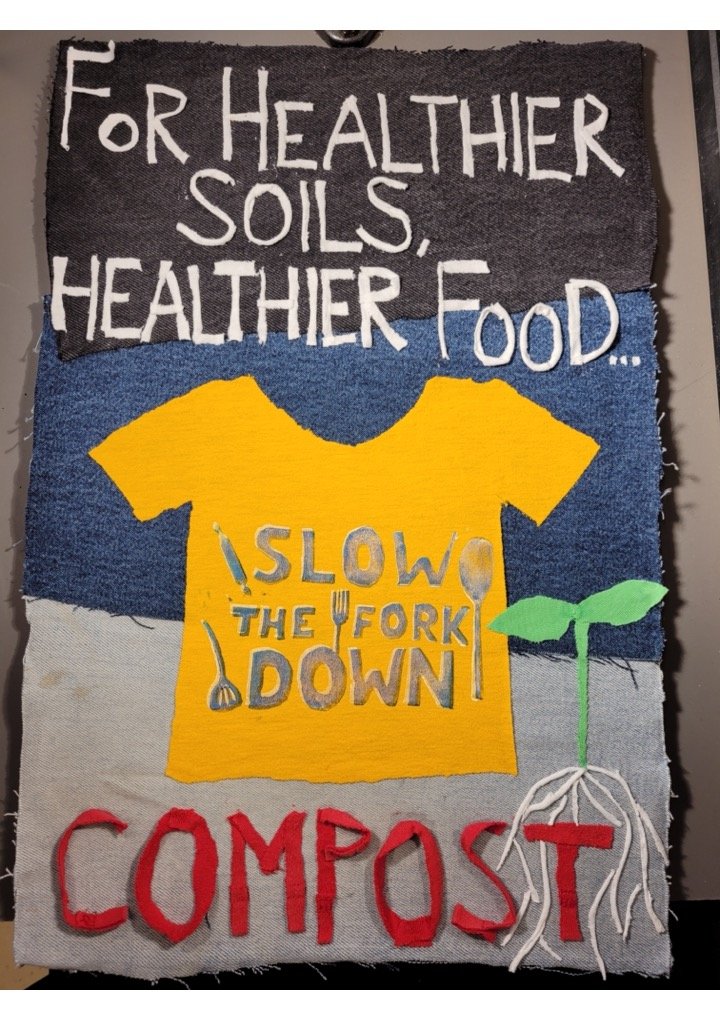
by Maris Linder
From Slow Food to Slow Fashion - Fashion is agriculture as much as food is agriculture. In today’s economy where farmer’s markets, agrotourism, and farm-to-table restaurants are trending among people who are finding love and special meaning in knowing where their food comes from and who produces it, buying food can be fresh, seasonal, and intimate. Why do we not have this experience when buying clothes? It is simple to picture your salad greens and bright tomatoes in a field of crops, but it may be more difficult to see your shirts and pants in a field of cotton, hemp, bamboo, or flax. Or for that matter, your sweaters in a herd of sheep and your leather boots among a pasture of cattle. Farmers and foodies following the organic, regenerative agriculture movement have put forth the science and discourse of the importance of soil health. Improving soil health simultaneously improves the health of food. Adding compost to soils and farm systems is a strong method for improving soil health. Compost adds organisms and bacteria that form symbiotic relationships with plant roots, improves soil structure, controls pests and diseases, recycles nutrients, and increases water-holding capacity. All of these listed characteristics of compost provide a basis for the health, resilience, and nutrition of the crop. Compost is a way to be resourceful with waste. Customers are paying more attention to regenerative agriculture practices as it applies to food sourcing, but minimal discussion is happening around fiber crops that are grown in huge areas of arable land in the United States, especially cotton. Your skin is the largest organ of your body and it has been proven that the chemicals on the fabrics of your clothes can be absorbed through the permeable layer that is your skin. A healthy, organic implement to fiber soils that compost is would not only improve the health of the soils but also grow fibers that are healthy for you to wear. Plus, clothing that is grown and processed organically, may also be composted back into the heathy soils where it came from. While fashion and textiles are deeply rooted in agriculture, they are extremely late to the current soil health party that farmers and foodies alike are basking in the beauty and deliciousness of fresh produce and the microbes are dancing away, feeding on the loud activity in regenerative soils. Slow Food is a current movement and concept that calls attention to the way food is produced, the cultural significance of food, and the importance of enjoying food. In the clothing and textile realm, we can use similar principles and passions to advocate for Slow Fashion.
This poster is made of upcycled materials including cardboard and old clothing of mine.
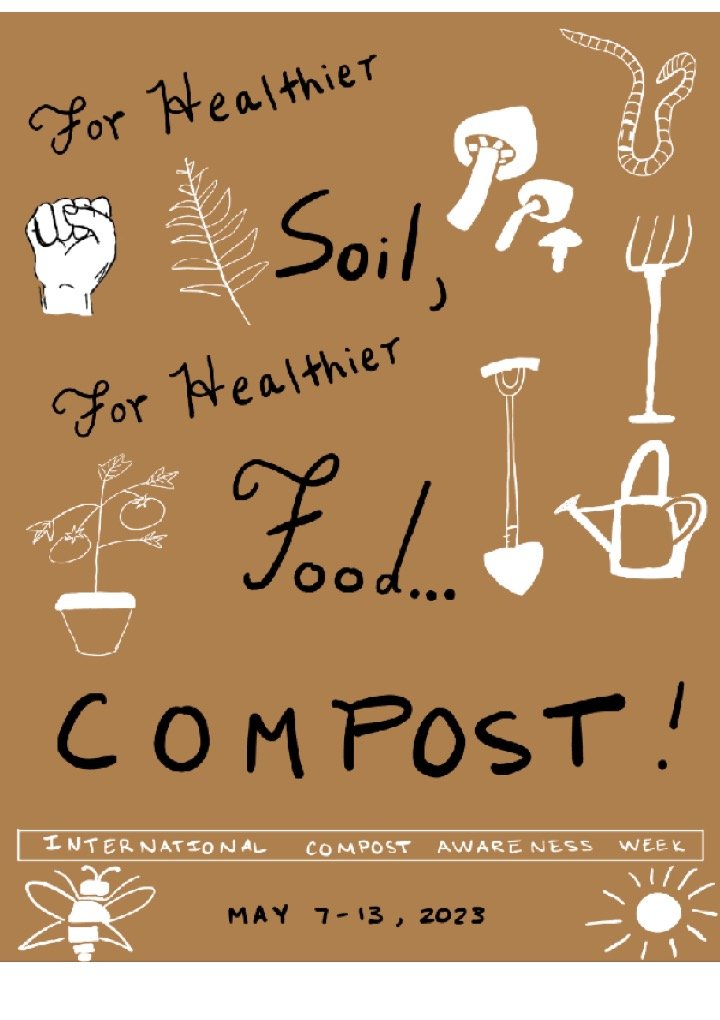
by Andrew AJ McLucas
For this poster, I wanted to focus on inclusive drawings for all audiences, address the importance of composting, and incorporate the holistic view of composting. I included pictures of a raised fist, a fern, mushrooms, an earthworm, a pitchfork, a shovel, a watering can, a tomato plant, an insect, and a sun. Composting is of the utmost importance for climate change mitigation, creating an inclusive economy, and improving the state of our food system. Composting should be used to regenerate depleted soils by adding organic matter and nutrients, enhancing the growth of organisms (represented by mushrooms, insects, fern, and tomato plants). Additionally, the raised fist is used symbolically to highlight social justice and inclusion in the composting industry. Composting should be accessible to everyone and is especially important to communities that do not have equal access to healthy food or green space. Likewise, composting involves much work, and there are numerous ways to compost - as we have discussed in class. I included various hand tools and earthworms to represent the diversity of compost methods. Ultimately, this poster aims to reach people who are not as aware of composting (most likely not industrial composters). Therefore, I wanted to prompt the viewer with images of recognizable things that will get people stoked about composting!

by Thomas Earley
For my final poster design, I wanted to include all of the elements that are necessary for the process to occur. This importance of these elements has been stressed to us throughout the whole semester. Without them, compost piles would not function. The four elements I included are a balanced Carbon to Nitrogen ratio, availability of Oxygen and airflow, importance of moisture content, and proper temperature maintenance. I chose to use a circular format for my design because of our discussion about the importance of circularity in modern waste management practices. For compost, there is no end use. Its creation builds healthy soils, which produces healthy food, which nourishes our body. When waste is created from that food, it can—and should—be reintroduced to the waste stream to produce more compost, continuing the cycle and closing the circle.



















